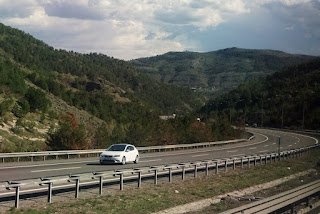May 9, 2022
May 9, 2022
After waking we checked out of our hotel and drove to the Golden Horn where we loaded on a boat for a tour of the 17-mile long Bosphorus Strait. We sailed north toward the Black Sea. Istanbul straddles both sides of the strait and stretches for miles in both directions. The coastline is jam-packed with wealthy homes, including Dolmabahce Palace. This was the modern Rococo-style home of the Ottoman Sultans starting in 1850. A similar waterfront palace is now a Four Seasons Hotel.
Further north we pass the distinctive Ortakoy Mosque on the water. It is one of the few Turkish mosques not in the traditional dome architecture. It was built in a Neo-Baroque style when the Ottomans wanted to appear more European.
A bit further we reach the Rumeli Fortress, a castle built by the Ottomans to help with the 1453 siege and capture of Constantinople. Sited at the narrowest point the fortress blockaded relief shipments to the embattled Byzantines hastening their defeat and surrender. We turn around before reaching the Black Sea.
This cruise reinforces that Istanbul is a beautiful city. The seashore, the blue water, the elegant homes, and the domed mosques paint a picturesque scene.
We get off the ship on the Asian side and drive up the hillside finding a little downtown of modern skyscrapers and lots of construction. We continue to the outskirts of Istanbul through a highly industrialized section. Turkey is no third world country. Farther along we reach the countryside, a scenic land of green rolling hills. We are travelling on a modern divided six-lane highway. It could be the US or Europe except for the ubiquitous mosque with its tall minaret. Even the tiniest cluster of hamlets has a mosque despite neighbors only a few hundred yards away.
Aimee and I practiced our Turkish on the way. One-two-three is beer, icki, ootch. Very foreign, for good reason. The Turks were a far eastern Asian tribe of horsemen who like the Mongols (or because of the Mongols) migrated to western Asia to settle. They brought their unique language with them.
For lunch we ate at a truck stop cafeteria and had Lentil soup and a stuffed tomato. I think it is the Turkish counterpart to the European stuffed pepper.
We continued cross-country to Ankara. This city was chosen as the capital of the new Republic of Turkey a hundred years ago after the War of Independence. This location was considered safer from foreign invasion than coastal Istanbul. We arrive in the evening in downtown Anakara. After a short rest we walk down the street to a Kebab restaurant. We have a spicy Lentil (we think) soup and a chicken Shish (skewer) Kebab (roasted meat). You can almost imagine this being the typical meal of migrating Turkish horsemen eating around an open campfire.
After waking we checked out of our hotel and drove to the Golden Horn where we loaded on a boat for a tour of the 17-mile long Bosphorus Strait. We sailed north toward the Black Sea. Istanbul straddles both sides of the strait and stretches for miles in both directions. The coastline is jam-packed with wealthy homes, including Dolmabahce Palace. This was the modern Rococo-style home of the Ottoman Sultans starting in 1850. A similar waterfront palace is now a Four Seasons Hotel.
Further north we pass the distinctive Ortakoy Mosque on the water. It is one of the few Turkish mosques not in the traditional dome architecture. It was built in a Neo-Baroque style when the Ottomans wanted to appear more European.
A bit further we reach the Rumeli Fortress, a castle built by the Ottomans to help with the 1453 siege and capture of Constantinople. Sited at the narrowest point the fortress blockaded relief shipments to the embattled Byzantines hastening their defeat and surrender. We turn around before reaching the Black Sea.
This cruise reinforces that Istanbul is a beautiful city. The seashore, the blue water, the elegant homes, and the domed mosques paint a picturesque scene.
We get off the ship on the Asian side and drive up the hillside finding a little downtown of modern skyscrapers and lots of construction. We continue to the outskirts of Istanbul through a highly industrialized section. Turkey is no third world country. Farther along we reach the countryside, a scenic land of green rolling hills. We are travelling on a modern divided six-lane highway. It could be the US or Europe except for the ubiquitous mosque with its tall minaret. Even the tiniest cluster of hamlets has a mosque despite neighbors only a few hundred yards away.
Aimee and I practiced our Turkish on the way. One-two-three is beer, icki, ootch. Very foreign, for good reason. The Turks were a far eastern Asian tribe of horsemen who like the Mongols (or because of the Mongols) migrated to western Asia to settle. They brought their unique language with them.
For lunch we ate at a truck stop cafeteria and had Lentil soup and a stuffed tomato. I think it is the Turkish counterpart to the European stuffed pepper.
We continued cross-country to Ankara. This city was chosen as the capital of the new Republic of Turkey a hundred years ago after the War of Independence. This location was considered safer from foreign invasion than coastal Istanbul. We arrive in the evening in downtown Anakara. After a short rest we walk down the street to a Kebab restaurant. We have a spicy Lentil (we think) soup and a chicken Shish (skewer) Kebab (roasted meat). You can almost imagine this being the typical meal of migrating Turkish horsemen eating around an open campfire.
Since most restaurants don't serve alcohol, we stop on the way back at an Irish Pub for a beer. They didn't have Guinness but the Local Efes beer was cheap because the Turkish Lira has suffered significant devaluation.




0 Comments:
Post a Comment
<< Home